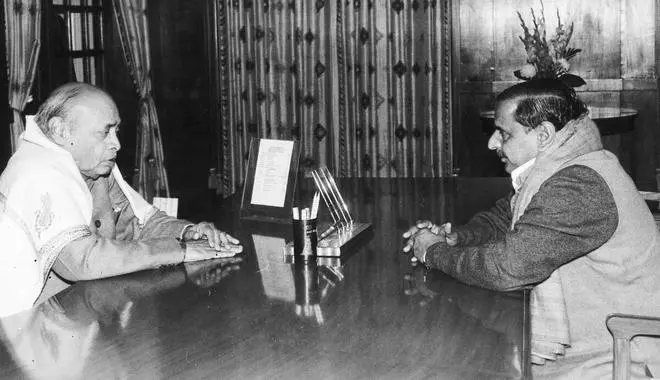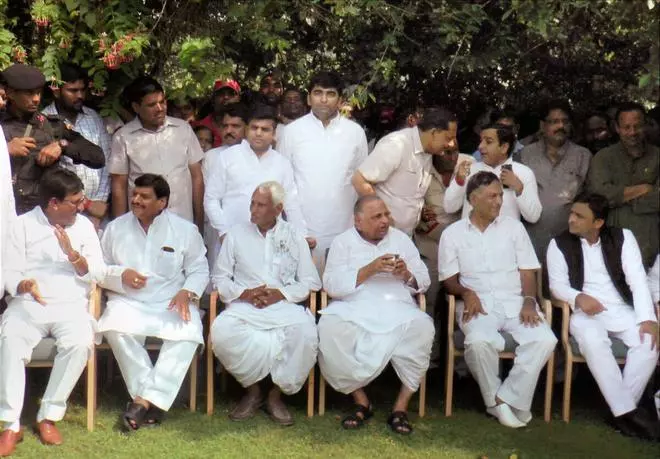
In this November 2021 file photo, Samajwadi Party founder Mulayam Singh Yadav gestures to supporters on his birthday, at the party office in Lucknow. (PTI)
The passing away of 82-year-old socialist leader Mulayam Singh Yadav this morning leaves the politics of social justice further impoverished at a time when it is facing its toughest challenge from Hindutva.
Among the tallest and most effective practitioners of the brand of socialism rooted in the Indian reality of caste discrimination, Mulayam Singh Yadav was a symbol of resistance to the rise of the BJP’s aggressive religious nationalism in the Hindi heartland.
Along with other followers of Gandhian Socialists led by Ram Manohar Lohia, such as George Fernandes, Lalu Prasad Yadav and Sharad Yadav, Mulayam or ‘Netaji’ as he was popularly called, was the most famous of politics of Mandal against the BJP’s Kamandal in the heyday of the Ramjanmabhoomi movement.
As LK Advani rode the chariot from Somnath to Ayodhya in the early 1990s to drag the BJP from the fringes to the mainstream of Indian politics, Mulayam propelled the backward caste movement as a powerful form of resistance.

Mayawati, LK Advani, Mulayam Singh Yadav and BJP leader Murli Manohar Joshi at State BJP president Kalraj Mishra’s daughter’s wedding in Lucknow on December 14, 1996. (The Hindu)
His electorally invincible coalition with the Bahujan Samaj Party (BSP) founder Kanshi Ram proved a potent antidote to the saffron tide with the slogan “miley Mulayam-Kanshi Ram, hawa mein ud gaye Jai Shri Ram (the coming together of Mulayam Singh Yadav and Kanshi Ram has driven Jai Shri Ram away)”.

Mulayam Singh Yadav flanked by Sharad Pawar, the Nationalist Congress Party leaders, and PA Sangma during their meeting on electoral alliance in the Capital, New Delhi on July 17, 1999. (The Hindu archives)
The tide of backward caste assertion witnessed Mulayam becoming the Chief Minister of Uttar Pradesh for three terms, also serving as Defence Minister in HD Deve Gowda’s and IK Gujaral’s Cabinet between 1996-98 and as an MP from Mainpuri, Azamgarh and Sambhal.

Bharatiya Janata Party activists burning effigies of Mulayam Singh Yadav and Mayawati against FDI in multi-brand retail issue in Patna on December 7, 2012. (Ranjeet Kumar)
This was no mean feat for someone who came from a non-political, farming family in Saifi village, Ittawah district in central Uttar Pradesh. Mulayam’s father, Sudhar Singh, wanted him to become a wrestler. But destiny had charted another route. He met his original mentor, MLA of Jaswantnagar Nathu Singh, who was impressed with Mulayam’s skills and charisma at a local wrestling ring.
The young Mulayam started his political career under Nathu Singh’s tutelage, becoming Samyukta Socialist Party MLA from Jaswantnagar in 1967 when he was only 28-year-old. From here, close contact with Raj Narain and Ram Manohar Lohiya during the turbulent phase of the Emergency led Mulayam to become a street fighter.

In this file photo, the then Prime Minister PV Narasimha Rao is holding talks with Mulayam Singh Yadav (who was the Chief Minister of Uttar Pradesh at that time) in New Delhi on December 10, 1993. (The Hindu archives)
On his bicycle, which later became the election symbol of the Samajwadi Party that he launched after separation from the Janata Dal in 1992, Mulayam would campaign on the streets and distribute political pamphlets. He was made a minister in the post-Emergency Janata Dal government and moved towards Rashtriya Lok Dal of Chowdhary Charan Singh in 1980.

Mulayam Singh Yadav, when he was the Defence Minister, arrives at Parliament to attend the special session in New Delhi on August 26, 1997. (The Hindu archives)
From his first term as Chief Minister in 1989, it was a struggle against the rising tide of the Ramjanmabhoomi movement, which propelled the BJP to power in Uttar Pradesh. His alliance with the BSP in 1993 led him to defeat the BJP and become Chief Minister again.

Mulayam Singh Yadav, Akhilesh Yadav, Shivpal Singh Yadav and other family members during the Diwali celebration in Etawah. (PTI/file photo)
But Mulayam’s rich career and politics were plagued by the absence of a concrete policy vision for social justice and a narrow, clannish style of politics. Even given the reality of dynasties appropriating political parties in different parts of the country, Mulayam’s is an exceptional case — the Yadavs from Saifi are the biggest clan in Indian politics, with as many as 20 members of the same family being members of the Samajwadi Party (SP).
His son Akhilesh Yadav was propelled as Chief Minister after SP won the Uttar Pradesh Assembly Elections in 2012. His brother Shivpal Yadav with whom Akhilesh has fought a prolonged battle for the control of the party, is still an MLA, as are other members of the clan, including daughter-in-law Dimple Yadav, brother Ramgopal Yadav, nephew Dharmender Yadav and so on who have been intermittently elected to Parliament on the SP ticket.

Mulayam Singh Yadav with his wife Sadhna Singh and daughter-in-law, Aparna Yadav, son, Prateek Yadav and grand children during the birthday celebration of Prateek’s daughter in Lucknow. (Rajeev Bhatt)
The contradiction between being a socialist ideologue and petty nepotism is as stark as the muscleman culture that the Yadavs promoted during their tenures at the top office. Controversies such as the rape and molestation incidents at Rampur Tiraha during the Uttarakhand movement and the infamous “Guesthouse scandal” where the BSP chief Mayawati was held hostage by SP goons only furthered the party’s image as a congregation promoting lumpenism.
The fact that Uttar Pradesh slid further down the scales in all human development indices and overall progress in the almost four decades that Mulayam remained at the fulcrum of regional politics has only eroded the SP’s popularity.

Samajwadi Party president and son Akhilesh Yadav felicitates party’s founder Mulayam Singh Yadav on his birthday, at party office in Lucknow, Monday, November 22, 2021 (PTI/File photo)
Mulayam’s health started deteriorating in the past few years, which witnessed his son Akhilesh Yadav effectively replacing him as the SP chieftain and the tallest leader. For a socialist leader who came from a humble background, the promise of change and social justice has been belied by narrow concerns of family and clan.
Akhilesh Yadav does not possess his father’s rootedness and strategic genius when the BJP has propelled its political behemoth through its most powerful and influential leader, Narendra Modi.
Mulayam’s promise was much bigger than the legacy he leaves behind.
Published on October 10, 2022

Comments
Comments have to be in English, and in full sentences. They cannot be abusive or personal. Please abide by our community guidelines for posting your comments.
We have migrated to a new commenting platform. If you are already a registered user of TheHindu Businessline and logged in, you may continue to engage with our articles. If you do not have an account please register and login to post comments. Users can access their older comments by logging into their accounts on Vuukle.